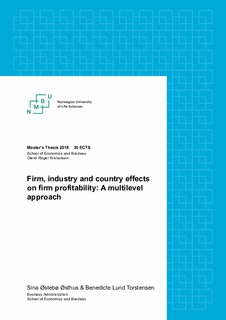| dc.description.abstract | The objective of this master thesis is first and foremost to examine to what degree firm, industry and country effects influence firm profitability. As such, this thesis revisits an ongoing discussion within strategic management regarding the main sources of firm profitability variances. Simultaneously, we bring in new elements and thus extend previous research. First, we apply a different measure of firm profitability, namely return on invested capital (ROIC), which to our knowledge has not previously been applied in such a study. Second, we integrate elements from corporate finance and examine whether degree of operating leverage and unlevered beta influences firm profitability. Finally, we elaborate on Bamiatzi, Bozos, Cavusgil and Hult’s (2016) study, and examine the relative role of firm, industry and country effects on firm profitability during changing economic environments. The data in this study is based on ROIC from publicly traded firms in the G-10 countries during a twelve-year time span (2005-2016). In our analysis we employ a mixed effects model in a hierarchical linear multilevel model (HLM) and use an intra-class correlation coefficient (ICC) to establish the relative role of firm, industry and country effects on firm profitability. Our results for the overall period (2005-2016) indicate that firm, industry and country effects accounts for respectively 88,93%, 9,48% and 1,60% of the variance in firm profitability, and hence, these effects are all of relevance in determining firm performance. When examining these effects during a changing economic environment, firm effects become stronger during a recession, whereas industry and country effects lose some of their explanatory power. As for degree of operating leverage we find no significant results. Unlevered beta on the other hand,
has a significant small negative coefficient during the recovery period (2012-2016), indicating an inverse relationship to the overall market. In addition, our research establishes that by incorporating degree of operating leverage and unlevered beta to our model, firm effects gain importance, while country and especially industry effects lose some of their explanatory power in determining firm profitability. As such, our findings indicate that firm effects account for the majority of the variance in firm profitability, and thus, firms are to a great length responsible for their own success. This implication is particularly prominent during periods of economic downturns. | nb_NO |

